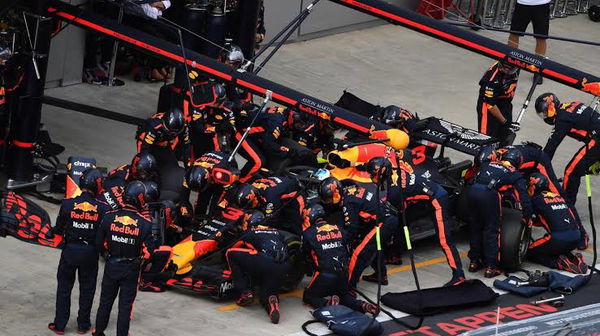

During a race, every car needs to stop midway for fuel and tires, unless it is a Formula E car. Many racing series always have their cars come in for fuel and tires, like F1, NASCAR, IndyCar, WEC and many more. An F1 pitstop has several elements and personnel involved in servicing one car.
Details of a typical F1 pitstop
Up until 2010, F1 used to have mid-race refueling, but it has been banned since then. So, the only purpose for cars to pit is to change tires or to change the front wing in an emergency.
ADVERTISEMENT
Article continues below this ad
The crew sometimes makes minor adjustments to the front wing. Normally, drivers and teams make anywhere between 1 and 3 pit stops during a race. The number of F1 pitstops also depends on the individual circuit and race specifics.
The crew usually springs into action, one lap before a scheduled pit stop. They must be ready with fresh tires and required pit equipment. Unlike in IndyCar or in NASCAR, where the crew has to wait for the car to enter the pit box, the F1 crew is already waiting. The only exception is the rear-jack man.
Formula One limits the teams to a single pit crew for both cars. So, each F1 team needs to carefully plan each stop so that one driver does not hold up his teammate. However, with meticulous timing, the teams can ‘double-stack’ without losing significant time.
During the refueling era
From 1994 until 2009, teams could play around with fuel strategies, by either running low fuel loads or a higher one. At that time, around 20 mechanics were needed to service one car as fast as possible. Routine stops lasted between six to 12 seconds depending on the fuel strategies.
However, the pit crew also had to be watchful of potential problems like fuel pump failure or drivers going too early and ripping off the fuel nozzle.
Owing to the risks during refueling, mechanics wore fire-resistant suits and flame-resistant gloves, long underwear, balaclava, socks, and shoes. Their attire was, therefore, very similar to that of F1 drivers.

How many members are in a typical F1 pit crew?
Four wheel-gunners (one for each wheel, use a tire gun to remove the car’s lug nut and reinstall it on the new tire.
Eight tire carriers, four to remove the old set and another four to fit in the fresh new set. There are also two members to operate the stabilizers on each side of the car.
If needed, the front-wing men make tweaks to the front wing angle and/or change the entire front wing in emergencies.
The front and rear jack men use lever-type jacks to lift the car, making it easier and faster for the tire crew to replace the tires.
It can be argued that the front jack man has the most dangerous job as he has to stand directly in front of the car as it enters its pit box. There have been instances of mechanics getting injured in the past when drivers overshot or failed to stop in time.
In case of a fire, another crew member stands by with a hand-held fire extinguisher in case of an emergency.
ADVERTISEMENT
Article continues below this ad

via Imago
This is what happens when a pit stop goes wrong
Finally, there is the lollipop man who helps guide the driver to his pit box. He then holds it in a position to remind the driver to stay on the brakes while the tires are swapped. Then he also instructs the driver to put the car in first gear once the jacks are lowered. Finally, he waves him out of the pit box.
ADVERTISEMENT
Article continues below this ad
Changes in the F1 pitstop in the post-refueling era
With refueling banned in F1 from the 2010 season onwards, the refueller’s role is now rendered obsolete. However, there is also another member who is ready with a starter tool. His job is to restart the car in case of engine stalling during the pit stop.
However, that too was rendered obsolete with the introduction of anti-stall systems. The drivers themselves can operate this independently, with the help of the car battery
ADVERTISEMENT
ADVERTISEMENT
ADVERTISEMENT
ADVERTISEMENT

